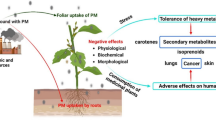Abstract
Leghaemoglobin, a protein present in root nodules of soybean (Glycine max (L.) Merr.), generates the highly reactive hydroxyl radical (·OH) upon incubation with hydrogen peroxide (H2O2). The H2O2 appears to cause breakdown of the haem, releasing iron ions that convert H2O2 into ·OH outside the protein. Oxyleghaemoglobin (oxygenated ferrous protein) is more sensitive to attack by H2O2 than is metleghaemoglobin (ferric protein). The possibility of oxyleghaemoglobin breakdown by H2O2 and formation of damaging ·OH may explain why the root nodule is equipped with iron-storage proteins and enzymes that can remove H2O2.
Similar content being viewed by others
References
Appleby, C.A. (1974) Leghemoglobin. In: The biology of nitrogen fixation, pp. 521–554, Quispel, A., ed. North-Holland, Amsterdam
Appleby, C.A., Nicola, N.A., Hurrell, J.G.R., Leach, S.J. (1975) Characterization and improved separation of soybean leghemoglobins. Biochemistry 14, 4444–4450
Aruoma, O.I., Halliwell, B., (1987) Superoxide-dependent and ascorbate-dependent formation of hydroxyl radicals from hydrogen peroxide in the presence of iron. Are lactoferrin and transferrin promoters of hydroxyl radical generation? Biochem. J. 241, 273–278
Aviram, I., Wittenberg, B.A., Wittenberg, J.B. (1978) The reaction of ferrous leghemoglobin with hydrogen peroxide to form leghemoglobin (IV). J. Biol. Chem. 253, 5685–5689
Bergersen, F.J. (1980) Leghaemoglobin, oxygen supply and nitrogen fixation: Studies with soybean nodules. In: Nitrogen fixation, pp. 139–160, Stewart, W.D.P., Gallon, J.R., eds. Academic Press, London New York
Brunori, M., Rotilio, G., (1984) Biochemistry of oxygen radical species. Methods Enzymol. 105, 22–35
Dalton, D.A., Russell, S.A., Hanus, F.J., Pascoe, G.A., Evans, H.J. (1986) Enzymatic reactions of ascorbate and glutathione that prevent peroxide damage in soybean root nodules. Proc. Natl. Acad. Sci. USA 83, 3811–3815
Foyer, C.H., Halliwell, B. (1976) The presence of glutathione and glutathione reductase in chloroplasts: a proposed role in ascorbic acid metabolism. Planta 133, 21–25
Gutteridge, J.M.C. (1981) Thiobarbituric acid-reactivity following iron-dependent free radical damage to amino acids and carbohydrates. FEBS Lett. 128, 343–346
Gutteridge, J.M.C. (1986) Iron promoters of the Fenton reaction and lipid peroxidation can be released from haemoglobin by peroxides. FEBS Lett. 201, 291–295
Gutteridge, J.M.C., Richmond, R., Halliwell, B. (1979) Inhibition of the iron-catalysed formation of hydroxyl radicals from superoxide and of lipid peroxidation by desferrioxamine. Biochem. J. 184, 469–472
Halliwell, B. (1978) Superoxide-dependent formation of hydroxyl radicals in the presence of iron chelates. Is it a mechanism for hydroxyl radical production in biochemical systems? FEBS Lett 92, 321–326
Halliwell, B. (1985) Use of desferrioxamine as a “probe” for iron-dependent formation of hydroxyl radicals. Evidence for a direct reaction between desferal and the superoxide radical. Biochem. Pharmacol. 34, 229–233
Halliwell, B. (1987) Oxidative damage, lipid peroxidation and antioxidant protection in chloroplasts. Chem. Phys. Lipids, 44, 327–340
Halliwell, B., Grootveld, M. (1987) The measurement of free radical reactions in humans. Some thoughts for future experimentation. FEBS Lett. 213, 9–14
Halliwell, B., Gutteridge, J.M.C. (1981) Formation of a thiobarbituric-acid-reactive substance from deoxyribose in the presence of iron salts. FEBS Lett. 128, 347–352
Halliwell, B., Gutteridge, J.M.C. (1985) The importance of free radicals and catalytic metal ions in human diseases. Mol. Aspects Med. 8, 89–193
Halliwell, B., Gutteridge, J.M.C. (1986) Oxygen free radicals and iron in relation to biology and medicine. Some problems and concepts. Arch. Biochem. Biophys. 246, 501–514
Ko, M.P., Huang, P.Y., Huang, J.S., Barker, K.R. (1987) The occurrence of phytoferritin and its relationship to effectiveness of soybean nodules. Plant Physiol. 83, 299–305
Nash, D.T., Schulman, H.M. (1976) The absence of oxidized leghemoglobin in soybean root nodules during nodule development. Biochem. Biophys. Res. Comm. 68, 781–785
Pasternack, R.F., Halliwell, B. (1979) Superoxide dismutase activities of an iron porphyrin and other iron complexes. J. Am. Chem. Soc. 101, 1026–1031
Puppo, A., Dimitrijevic, L., Rigaud, J. (1982) Possible involvement of nodule superoxide dismutase and catalase in leghemoglobin protection. Planta 156, 374–379
Puppo, A., Halliwell, B. (1987) Formation of hydroxyl radicals from hydrogen peroxide in the presence of iron. Is haemoglobin a biological Fenton catalyst? Biochem. J., in press
Puppo, A., Rigaud, J., Job, D. (1981) Role of superoxide anion in leghemoglobin autoxidation. Plant Sci. Lett. 22, 353–360
Puppo, A., Rigaud, J., Job, D., Ricard, J., Zeba, B. (1980) Peroxidase content of soybean root nodules. Biochim. Biophys. Acta 614, 303–312
Richmond, R., Halliwell, B., Chauhan, J., Darbre, A. (1981) Superoxide-dependent formation of hydroxyl radicals: detection of hydroxyl radicals by the hydroxylation of aromatic compounds. Anal. Biochem. 118, 328–335
Sadrzadeh, S.M.H., Graf, E., Panter, S.S., Hallaway, P.E., Eaton, J.W. (1984) Hemoglobin is a Fenton catalyst. J. Biol. Chem. 259, 14354–14356
Sievers, G., Rönnberg, M. (1978) Study of the pseudoperoxidatic activity of soybean leghemoglobin and sperm whale myoglobin. Biochim. Biophys. Acta 533, 293–301
Wittenberg, J.B., Bergersen, F.J., Appleby, C.A., Turner, G.L. (1974) Facilitated oxygen diffusion. The role of leghemoglobin in nitrogen fixation by bacteroids isolated from soybean root nodules. J. Biol. Chem. 249, 4057–4066
Author information
Authors and Affiliations
Rights and permissions
About this article
Cite this article
Puppo, A., Halliwell, B. Generation of hydroxyl radicals by soybean nodule leghaemoglobin. Planta 173, 405–410 (1988). https://doi.org/10.1007/BF00401028
Received:
Accepted:
Issue Date:
DOI: https://doi.org/10.1007/BF00401028




